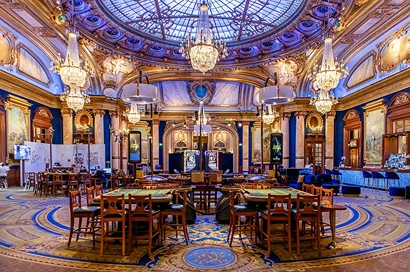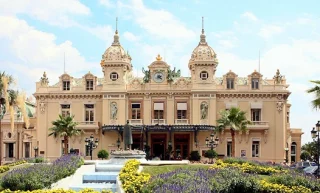Casino de Monte-Carlo: The Pinnacle of Monaco’s Glamorous Legacy
Perched on the sun-drenched cliffs of Monaco’s Monte-Carlo district, the Casino de Monte-Carlo, inaugurated in 1863, stands as an enduring symbol of opulence and sophistication, a physical casino legend born from the vision of Prince Charles III to rescue his principality from financial ruin. Designed by Charles Garnier, the famed architect behind Paris’s Palais Garnier, this Belle Époque masterpiece emerged from humble beginnings—its construction in the rugged Les Spelugues area (renamed Monte-Carlo, or “Mount Charles”) was funded by François Blanc, the “Magician of Monte-Carlo,” who transformed it into a beacon for Europe’s elite. With its marble atrium, Bohemian crystal chandeliers, and gold-leafed gaming rooms, the casino transcends mere gambling, offering a cultural and architectural experience that has lured royalty, celebrities, and thrill-seekers for over 160 years.
The Casino de Monte-Carlo’s physical grandeur is matched only by its cinematic mystique, immortalized as the playground of James Bond in films like GoldenEye and Never Say Never Again. Spanning 108,000 square feet, its gaming floor—though modest compared to modern giants—exudes an unmatched elegance with 700 slot machines and 50 table games, including French roulette, baccarat, and Texas Hold’em. Beyond gaming, the casino houses the Salle Garnier opera house and Les Ballets de Monte-Carlo, intertwining high stakes with high art. Owned by the Société des Bains de Mer (SBM), in which Monaco’s ruling Grimaldi family holds a stake, it enforces a unique rule: Monégasque citizens are barred from gambling, preserving its allure as a foreigners’ haven and reinforcing its status as a global icon of luxury and exclusivity.
A Symphony of Gaming and Grandeur
The gaming experience at the Casino de Monte-Carlo is a choreographed dance of tradition and prestige, where every detail—from the handcrafted tables made in SBM’s workshops to the croupiers’ impeccable service—reflects a commitment to excellence. The Salle Europe, with its frescoed ceilings and gilded accents, hosts classic games like trente-et-quarante and punto banco, while the Salle Renaissance and Salle des Amériques offer rows of modern slots under ornate decor. Betting ranges from €5 minimums on slots to astronomical stakes in the exclusive Salons Privés, reserved for high rollers invited by the casino’s discerning management. This curated atmosphere, paired with a strict dress code (jackets required after 2 p.m.), ensures that every spin of the roulette wheel feels like a moment of history.

Beyond the tables, the Casino de Monte-Carlo is a multi-sensory spectacle that extends its legend into dining, culture, and sheer extravagance. The Atrium, free to enter until 2 p.m., welcomes visitors with 28 onyx columns and a glass ceiling, leading to the Salon Rose restaurant, where seafood dishes are served amidst tobacco-stained murals from a bygone era. The adjacent Salle Garnier, opened in 1879, has staged operas and ballets for over a century, while the casino’s Place du Casino square buzzes with Ferraris and Bentleys, a living gallery of wealth. This seamless blend of gaming, art, and lifestyle—set against Monaco’s Mediterranean backdrop—makes the casino not just a destination but a physical embodiment of the principality’s ethos: luxury without compromise.
- Gaming Floor: 108,000 square feet with 700 slots and 50 table games.
- Cultural Venues: Salle Garnier opera house and Les Ballets de Monte-Carlo.
- Dining: Salon Rose and Le Train Bleu, offering gourmet cuisine.
- Entry Fee: €19 (includes €10 gaming voucher after 2 p.m.).
- Dress Code: Smart attire mandatory for gaming rooms post-2 p.m.
Casino de Monte-Carlo by the Numbers
| Feature | Details | Rating (Out of 5) |
|---|---|---|
| Gaming Variety | 700 slots, 50 tables, exclusive VIP | 4.7 |
| Architectural Beauty | Belle Époque design by Charles Garnier | 5.0 |
| Entertainment | Opera, ballet, and casino events | 4.8 |
| Visitor Experience | Luxury dining and strict entry rules | 4.6 |
| Historical Significance | Founded 1863, shaped Monaco’s economy | 5.0 |
The casino’s gaming variety earns high marks for its curated selection, though its smaller scale compared to modern mega-casinos limits its scope. Architecturally, it’s flawless—Garnier’s vision of marble, gold, and crystal remains unrivaled, earning a perfect score. Entertainment, bolstered by the Salle Garnier, is a standout, though slots dominate over live shows for casual visitors. The visitor experience is elite, with gourmet dining and a prestigious ambiance, but the €19 entry fee and dress code may deter some. Historically, it’s a titan—its profits once funded Monaco’s tax-free status, a legacy that endures despite diversification into tourism and finance.
The casino’s physical evolution reflects its adaptability, from its 1863 opening to expansions in 1878-79 by Garnier and Jules Dutrou, adding the opera house and gaming rooms like the Salle Blanche. Its survival through wars, economic shifts, and a 2020 pandemic closure showcases resilience, reopening with renewed vigor by 2021. The Place du Casino square, framed by the Hôtel de Paris and Café de Paris, amplifies its allure, hosting the Monaco Grand Prix’s glamour annually. This physical and cultural permanence ensures the Casino de Monte-Carlo remains a living legend, not a relic.
For high rollers, the Salons Privés offer a secretive haven, accessible by invitation only, where bets can soar into the millions amid privacy and personalized service. The My Monte-Carlo loyalty program enhances the experience, granting free entry to Silver-tier members and above, alongside tailored perks. This exclusivity, paired with its ban on local gambling, underscores a deliberate design: to captivate the world while preserving Monaco’s mystique. As a physical casino, it’s less about volume and more about prestige, a formula that keeps it atop the pantheon of real-world gaming icons.
- VIP Access: Salons Privés for invited high rollers only.
- Rewards: My Monte-Carlo program with free entry and perks.
- Transport: 15-minute walk from Monaco-Monte-Carlo station; casino parking available.
- Cultural Events: Annual opera season and ballet performances.
- Proximity: Steps from Hôtel de Paris and Jardins de la Petite Afrique.
The Casino de Monte-Carlo’s legend is woven into Monaco’s very fabric, its profits historically lifting the principality from obscurity to opulence. Stories abound—Joseph Jagger “broke the bank” in 1873 by exploiting a roulette wheel bias, while the 1913 black-streak roulette run saw gamblers lose millions betting on red. These tales, alongside its Bond-film cameos, fuel a mystique that’s as physical as its marble halls. The casino’s façade, with its twin turrets once housing Paris-Monaco clocks, gazes over a square where Nelson Mandela, Roger Moore, and countless tycoons have strolled, each adding to its lore.
Its physicality is a sensory marvel—stepping into the Atrium feels like entering a gilded time capsule, the air thick with anticipation as you pass beneath chandeliers to the gaming rooms. The Salle Europe’s craps tables hum with energy, while the Salle Blanche’s terrace offers Mediterranean views between bets. The casino’s no-clock policy (save that historical anomaly) traps time, urging players to linger. Even non-gamblers find allure in its morning tours (10 a.m.-1 p.m.), where the €19 fee unveils art and architecture without a wager. This accessibility, paired with its exclusivity, keeps it a pilgrimage site for travelers and dreamers alike.
As Monaco modernizes, with rivals like Sun Casino offering contemporary vibes, the Casino de Monte-Carlo holds its ground, its 2025 calendar promising opera premieres and Grand Prix festivities. Its 108,000 square feet may pale next to Macau’s giants, but size isn’t the point—prestige is. From Winston Churchill’s rumored tunnel jaunts from the Hôtel de Paris to the 2021 No Time to Die premiere hosted by Prince Albert II, it remains a physical nexus of history and glamour. For those who cross its threshold, the Casino de Monte-Carlo isn’t just a casino—it’s a legend etched in stone, gold, and the collective imagination, a real-world icon that defies time.

